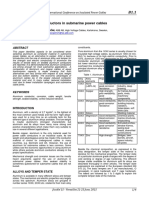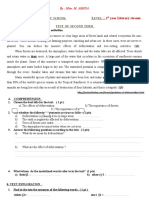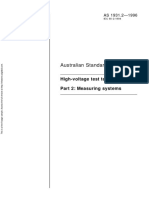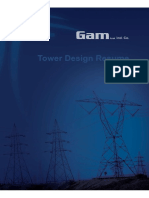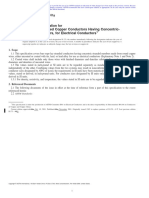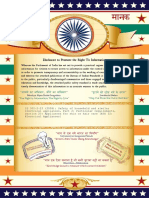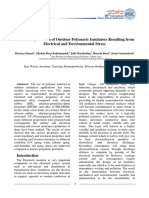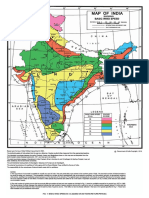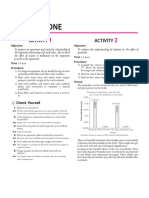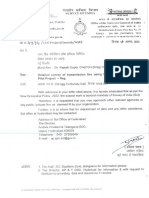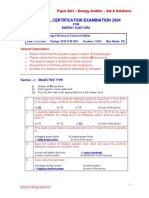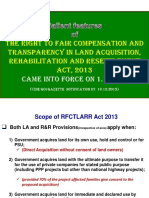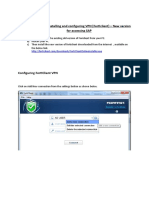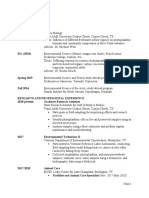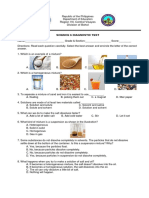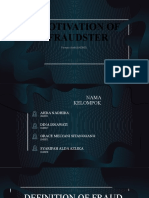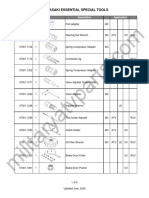Damage
Damage
Uploaded by
Neeraj Singh GautamCopyright:
Available Formats
Damage
Damage
Uploaded by
Neeraj Singh GautamCopyright
Available Formats
Share this document
Did you find this document useful?
Is this content inappropriate?
Copyright:
Available Formats
Damage
Damage
Uploaded by
Neeraj Singh GautamCopyright:
Available Formats
See discussions, stats, and author profiles for this publication at: https://www.researchgate.
net/publication/335464488
BIRD DAMAGE TO COMPOSITE INSULATORS
Conference Paper · January 2000
CITATION READS
1 2,576
4 authors, including:
Peter Dulhunty
Dulhunty Works
7 PUBLICATIONS 5 CITATIONS
SEE PROFILE
Some of the authors of this publication are also working on these related projects:
CIGRE B2.007 View project
CIGRE B2.11 View project
All content following this page was uploaded by Peter Dulhunty on 29 August 2019.
The user has requested enhancement of the downloaded file.
BIRD DAMAGE TO COMPOSITE INSULATORS
By: Peter W. Dulhunty ( email – sales@dulhunty.com )
Philip W. Dulhunty
J.A. (Tony) Gillespie ( email – tgillesp@powerlink.qld.gov.au )
SUMMARY
This paper presents the recent experience with bird damage to composite insulators in Queensland, Australia.
Options to prevent bird damage are presented along with the chosen solution for current transmission line
projects.
helicopter surveys and spot tower climbing indicated
the bird damage was in localised sections. Sixty two
1.0 INTRODUCTION bird damaged insulators were replaced bringing the
total to 165. Note that the total number of insulators
In the last eighteen months some transmission line on the line is around 6000. All insulators have
composite insulators have suffered damage from silicone rubber sheds. The vast majority of
birds during the construction period. The apparent insulators were longrods, with a small quantity of
conditions conducive to bird damage have been bridging posts used on tension structures. On
identified. A number of options for controlling bird vertical suspension insulators, the damage is almost
damage are considered and the solution adopted exclusively at the tower end and at the live end
for current projects is presented. adjacent to the corona ring. Horizontal tension
strings suffered damage all the way along the
Some unanswered questions relating to bird insulator. Note the damage to the tops of sheds of
damage of composite insulators have prompted tension insulators in Figure 1. Shed damage and
future work. sheath damage has occurred. Of most concern are
insulators with the fibreglass core exposed. Note
the core has been exposed on the second insulator
from the right in Figure 2. The concern is that these
insulators may fail due to either electrical tracking or
brittle fracture. The sheath damage to suspension
insulators adjacent to the corona ring is very difficult
to identify from helicopters or from the ground.
2.0 BIRD DAMAGE PROBLEM
Trial installations and complete lines have been built
prior to 1998 without bird damage to composite
insulators. However, in 1998 and 1999, two
transmission lines suffered bird damage to
composite insulators during the construction period.
Bird damage was discovered just before
commissioning the 336km, double circuit 275kV
Calvale - Tarong transmission line in November
1998. A total of 103 bird damaged insulators were
changed. The maximum time of exposure was
eight months. There were more insulators with
damage that could not be replaced before Fig. 1 Bird damaged insulators on tension tower.
commissioning as there was insufficient time and no
more suitable spares available. Subsequent
IEEE Winter Meeting, Singapore, January 23 to 27, 2000 Page 1
Fig. 2 Bird damaged insulators close up.
One tension tower suffered extensive bird damage
to all 24 composite longrods on the tower.
A 110 kV pole line with horizontal vee composite
insulators also suffered bird damage during
construction in 1999. The 42km, double circuit,
110kV Middle Ridge - Oakey Power Station line was
commissioned in mid 1999. Longrods, horizontal
vee posts and vertical bridging posts were
damaged. Refer to photographs of the damage in
Figures 3 and 4. All bird damaged insulators were
replaced before commissioning. Approximately 60
insulators were replaced. The longest time of
exposure was four months. All insulators used have Fig. 4 Bird damaged horizontal vee post and
silicone rubber sheds. There were approximately longrod insulators.
3800 insulators installed on the transmission line.
In 1999, the 140km, double circuit 275kV Tarong -
Blackwall line was also under construction. This
line suffered no damage from birds. Earlier 275kV
lines constructed with composite insulators from
Karana Downs to Rocklea in 1992 and from
Springmount to Woree in 1997/1998 suffered no
damage. There was however, some reported bird
damage on the 110kV Middle Ridge - Torrington
concrete pole, double circuit, composite line post
transmission line during construction in 1995. This
line runs parallel to the Middle Ridge - Oakey Power
Station line for some of the route.
Refer to the map on the back page showing the
location of transmission lines in Queensland.
Fig. 3 Bird damaged long rod insulator close up. Bird damage has also been reported by TransGrid
in New South Wales to 132kV EPDM line posts on
the Moree - Armidale line during construction.
Energex suffered extensive damage to six silicone
shed line posts at Rocklea during construction of a
110kV line in 1999.
At the 1998 Cigré Paris meeting, bird damage was
reported in Switzerland.
IEEE Winter Meeting, Singapore, January 23 to 27, 2000 Page 2
3.0 SURVEYS AND ANALYSIS morning. They feed until about 8 or 9.30 am then
move away, usually returning in the afternoon to
Ground surveys were conducted on both the feed again. Sunflower seeds appear to be their
Calvale - Tarong and Middle Ridge - Oakey Power preferred seed.
Station lines to establish why insulators were
damaged severely in some areas but not touched in Observations at this site suggest that bird damage
other areas of the line. (See reference 1). to insulators is very likely near crops such as
sunflower, sorghum and corn with a reliable water
The damage was caused mostly by galahs supply and with gum trees close by.
(scientific name Eolophus Roseicapilla) but also by
sulphur crested cockatoos (scientific name Cacatua
Galerita). The surveys suggested that these birds
are more prevalent in areas where water is
available (in creeks or dams) close to grain growing
fields. Nesting trees close to the transmission line
are also considered to be a factor increasing bird
population close to the line. Galahs were also
observed in close proximity to the line in cattle
grazing areas with water close by. It has been
suggested that birds may visit on a seasonal basis
e.g. when water and grain are available or to collect
insulator shed material for nesting. It should be
noted that even a single bird could cause severe
damage.
The insulator damage is thought to be from chewing
rather than eating. Both species responsible for
chewing the insulators have parrot like beaks. Their
beaks grow continuously throughout their lives.
Cockatoos will chew timber and even softer metals
such as lead or aluminium. Chewing is necessary to
wear down their beaks. Refer to attached photo of a
sulphur crested cockatoo chewing an insulator in
Figure 5.
Observations suggest that damage occurs only
during the construction period when the line is de-
energised, and no bird damage occurs when the
line is energised. However, bird damage can occur
when the line is de-energised for maintenance. It is
thought that the electric field is unpleasant for birds
when the line is energised. The electric field profile
is such that there is a relatively low absolute electric
Fig. 5 Sulphur crested cockatoo on insulator.
field value, and gradient, at the earthed end of the
insulator. It is possible that birds could chew the
The policy adopted for both Calvale-Tarong and
insulators at the structure end, even when the line is
Middle Ridge-Oakey lines was to replace all bird
energised. If this is the case, then large diameter
chewed insulators, independent of the extent of
sheds adjacent to the structure may be required to
damage. This was to ensure all insulators were in
prevent the birds chewing the “dead” end of the
an undamaged state, initially. Later inspections
insulator.
would then indicate whether energised insulators
are chewed by birds.
On the Middle Ridge - Oakey Power Station line,
pole number 99069 at the Torrington Tee is in close
It is suggested that an insulator must be replaced if
proximity to a seed farm (Pioneer Overseas
the fibreglass core is exposed or there is significant
Corporation). At this pole, the composite insulators
shed damage. Significant shed damage, in this
suffered extensive bird damage. The main crops
context, is reduced creepage length. Insulators with
grown are sunflower, sorghum and corn. Galahs
long radial splits in a shed, such that the split may
flock to this area in large numbers (over 500) to eat
propagate to expose the core, should also be
the seeds. From September to March, the galahs
replaced. Bird damage to the outer radial section of
have been observed to fly in from their roosting
a shed is not considered a problem, provided the
sites in the nearby hills at around 6 o'clock in the
damage is only to the rim and does not extend
IEEE Winter Meeting, Singapore, January 23 to 27, 2000 Page 3
closer than say, 50% of the radial length toward the Queensland are large and helicopters are used to
core. keep maintenance costs down. Discs are too heavy
for efficient helicopter work. Back in 1997 the
4.0 OPTIONS greatest risk was considered to be the lifetime of
composites. However, it was anticipated that the life
An extensive literature search was undertaken to would be 15 to 20 years.
find possible solutions to the bird damage problem.
A number of options for bird control were identified 5.0 SOLUTION
in reference 2. Bird control methods considered
include: After a survey, the solution adopted for the
275/330kV Queensland - New South Wales
(a) Shooting Interconnector, currently under construction, is a
(b) Chemical deterrents combination of plastic covers and discs. The line
(c) Gas powered automatically fired cannon length is 330km in Queensland.
(d) Broadcasting prerecorded audible noise of birds
in danger Tubes, aptly named “Polly-mar Shrouds” have been
(e) Ultrasonic scarers manufactured from 1mm thick polypropylene sheet
(f) Electric fences preformed into a roll and held in place with velcro
(g) Rotating mirrors strips. The birds can only chew a material if they
(h) Metallic spikes can obtain a perch to sit on, within pecking distance.
(i) Scarecrows They have claws, which can grip around most
(j) Bird kites in the shape of eagles or falcons transmission line conductors, fittings, hardware and
(k) Eye-spots polymeric insulator sheds with relative ease. The
(l) Plastic snakes or cats tube acts as a barrier to protect the insulator sheds
(m) Border collie dogs and the rigid slippery surface of the plastic tube
prevents bird claws from taking a hold. The shrouds
Most of these options have been tried without much are fitted over the insulator before the insulator is
success. Most parrot type birds, including cockatoos attached to the structure. There is a loop at one end
and galahs, are relatively intelligent and can be of the shroud to facilitate rapid removal by
trained to talk and perform various tasks. Shooting helicopter just before commissioning. This loop can
or poisoning, or in fact any deterrent that will harm be grabbed by a hook, from a helicopter or from the
the birds, is frowned upon and not accepted by any structure, and the whole shroud peeled off in one
of the environmental agencies. movement without damage to the shroud or
insulator. Refer to a photograph of a helicopter
Plastic or cardboard tubes covering the insulator is removing a protective cover from an insulator on the
another possibility for protecting the insulators. second last page. In volume, the estimated cost of
purchasing, fitting and removing one cover is 30%
Another option is to fit disc insulators rather than C.I. To keep costs down, the tubes are re-useable.
composites. For 18 disc insulator strings suitable
for 275/330kV, the extra cost of fitting and On a dozen tension towers assessed to be very
purchasing discs, rather than composites, is 70% high risk, discs are to be fitted. As the line is
the cost of an 18 disc equivalent composite currently under construction it will be at least six
insulator longrod (abbreviated to 70% C.I.). (Note months before the line is energised.
the cost of discs installed is 170% C.I.)
The cost of replacing a bird chewed insulator during
construction is 200% C.I. including labour and
materials. If the damage cannot be repaired until
after commissioning, then the cost of replacing a
bird chewed insulator is 300% C.I. including labour
and materials.
For the Calvale-Tarong line, the estimated cost
saving of composite insulators over discs, and
taking into account installation and bird damage, is
AUS$450,000.
In 1997, Powerlink decided to use composite
insulators on all new transmission lines. Composites
were chosen over discs for lower capaital cost and
to facilitate helicopter maintenance. Distances in
IEEE Winter Meeting, Singapore, January 23 to 27, 2000 Page 4
6.0 QUESTIONS AND FUTURE WORK
Bird damage has occurred on composite insulators
during construction before energisation.
The solution chosen to the bird damage problem
was to fit covers over the insulators during
construction.
The bird covers have only recently been installed
and they will not be removed until mid 2000.
On a few selected tension towers deemed to be
high risk, discs were fitted.
EPDM is tougher than silicone but both have
suffered bird damage. It is wondered if shed
material can be formulated that birds find
distasteful.
Further inspections will be programmed to
determine whether bird damage occurs on
energised lines.
IEEE Winter Meeting, Singapore, January 23 to 27, 2000 Page 5
IEEE Winter Meeting, Singapore, January 23 to 27, 2000 Page 6
View publication stats
You might also like
- Foundations of Social Policy Social Justice in Human Perspective 6th Edition Barusch Test BankDocument12 pagesFoundations of Social Policy Social Justice in Human Perspective 6th Edition Barusch Test BankDianaWyattymjpb100% (16)
- Chris Hinshaw - Aerobic Capacity - Endurance Speed & Long Run Progression & Sample Run WorkoutsDocument2 pagesChris Hinshaw - Aerobic Capacity - Endurance Speed & Long Run Progression & Sample Run Workoutsalexpla37100% (6)
- Use of Aluminum Conductors in Submarine Power CablesDocument6 pagesUse of Aluminum Conductors in Submarine Power CablesThai AnhNo ratings yet
- Corona On Interphase SpacerDocument2 pagesCorona On Interphase Spacertanto_deep_15100% (1)
- Copper-Clad Aluminum Bar For Electrical Purposes (Bus Bar)Document5 pagesCopper-Clad Aluminum Bar For Electrical Purposes (Bus Bar)Tuanbk NguyenNo ratings yet
- Confidential InformationDocument1 pageConfidential InformationJose HansonNo ratings yet
- 2 Term Test DeforestationDocument2 pages2 Term Test Deforestationسدن آرماNo ratings yet
- Ansi C29.8 PDFDocument12 pagesAnsi C29.8 PDFAlbertoNo ratings yet
- PLP - Dogbone Vibration DamperDocument5 pagesPLP - Dogbone Vibration DamperHFandino1100% (1)
- Part 1 - CEMIG, Brazil SpecificationDocument30 pagesPart 1 - CEMIG, Brazil SpecificationHenrique ReisNo ratings yet
- Specifications: S&C Loadbuster Disconnect SwitchesDocument20 pagesSpecifications: S&C Loadbuster Disconnect SwitchesJonathan Sebastian SalinasNo ratings yet
- Bare Overhead Conductors-2015Document63 pagesBare Overhead Conductors-2015Weber HahnNo ratings yet
- Vibration Dampers - An Evolution in AustraliaDocument12 pagesVibration Dampers - An Evolution in Australiaskc3128No ratings yet
- HV Bushing (Type C)Document6 pagesHV Bushing (Type C)Ari Wibowo NugrohoNo ratings yet
- Spacers and Spacer DampersDocument14 pagesSpacers and Spacer Dampersahmadove1No ratings yet
- CensDocument40 pagesCenstibananoNo ratings yet
- Iec (60227) 53Document2 pagesIec (60227) 53Hamed GeramiNo ratings yet
- As 1883-1992 Guide To Maintenance and Supervision of Insulating Oils in ServiceDocument8 pagesAs 1883-1992 Guide To Maintenance and Supervision of Insulating Oils in ServiceSAI Global - APACNo ratings yet
- As 1222.1-1992 Steel Conductors and Stays - Bare Overhead Galvanized (SC GZ)Document7 pagesAs 1222.1-1992 Steel Conductors and Stays - Bare Overhead Galvanized (SC GZ)SAI Global - APAC0% (1)
- Transpowr Aaac Bare Overhead Conductor: Aluminum Alloy Conductor Concentric-Lay-StrandedDocument3 pagesTranspowr Aaac Bare Overhead Conductor: Aluminum Alloy Conductor Concentric-Lay-Strandedgari_monsantoNo ratings yet
- Standards For Review.Document119 pagesStandards For Review.yasararafat12010No ratings yet
- String HardwareDocument56 pagesString Hardwareahmadove1No ratings yet
- As 1931.2-1996 High-Voltage Test Techniques Measuring SystemsDocument10 pagesAs 1931.2-1996 High-Voltage Test Techniques Measuring SystemsSAI Global - APACNo ratings yet
- Acsr DogDocument4 pagesAcsr DogjamilNo ratings yet
- HV Connectors Test Report PDFDocument21 pagesHV Connectors Test Report PDFMohammed ShoaibNo ratings yet
- As 4398.1-1996 (R2010) Insulators - Ceramic or Glass - Station Post For Indoor and Outdoor Use - Voltages GREDocument8 pagesAs 4398.1-1996 (R2010) Insulators - Ceramic or Glass - Station Post For Indoor and Outdoor Use - Voltages GRESAI Global - APACNo ratings yet
- E05 33 11 LV Distribution Power Cables v5Document77 pagesE05 33 11 LV Distribution Power Cables v5Anorld WalkerNo ratings yet
- Influence of Shed Profile On The Pollution Performance of Porcelain InsulatorsDocument4 pagesInfluence of Shed Profile On The Pollution Performance of Porcelain InsulatorsRamkumar N VaithilingamNo ratings yet
- XHIOLE (Cbe) 1x"S"/35 12/20kV: Product Specification EPM100051Document2 pagesXHIOLE (Cbe) 1x"S"/35 12/20kV: Product Specification EPM100051Fahad UsmanNo ratings yet
- Silicone Conductor Cover, Overhead Line Cover IndiaDocument6 pagesSilicone Conductor Cover, Overhead Line Cover IndiaNikhil MathewNo ratings yet
- Table Busbar - Tekno MegaDocument1 pageTable Busbar - Tekno MegaputrasejahtraNo ratings yet
- Experimental Study of Electrical Breakdown Voltage of A Glass Insulator Strings With Different Numbers of Broken UnitsDocument4 pagesExperimental Study of Electrical Breakdown Voltage of A Glass Insulator Strings With Different Numbers of Broken UnitsBoby GintingNo ratings yet
- Technnical Schedule of BR10-PS-25 - Reply - 20170814Document5 pagesTechnnical Schedule of BR10-PS-25 - Reply - 20170814HopNo ratings yet
- Dampers and Preformed RodsDocument8 pagesDampers and Preformed RodsJaime Arellano HuertaNo ratings yet
- AB PolelineDocument66 pagesAB Polelineronger15No ratings yet
- 1MRK502027-UEN B en Technical Reference Manual REG670 1.2Document998 pages1MRK502027-UEN B en Technical Reference Manual REG670 1.2svanand88No ratings yet
- Standard SDocument7 pagesStandard SMohan Kumar67% (3)
- TransPowr ACSS Bare Overhead ConductorDocument5 pagesTransPowr ACSS Bare Overhead ConductorHyrNo ratings yet
- Arcing DevicesDocument10 pagesArcing DevicessalvandyNo ratings yet
- Bus Bar Insulating ShroudsDocument3 pagesBus Bar Insulating ShroudsRohit SharmaNo ratings yet
- Optical Fibers - Optical Attenuation Variation - Method of TestDocument8 pagesOptical Fibers - Optical Attenuation Variation - Method of Test张骏No ratings yet
- Shakun Polymers Limited: Spl-Afosr High Performance PVC CompoundDocument2 pagesShakun Polymers Limited: Spl-Afosr High Performance PVC CompoundquycoctuNo ratings yet
- Ribe S D P Y I: Pacer Ampers Rotect OUR NvestmentDocument8 pagesRibe S D P Y I: Pacer Ampers Rotect OUR NvestmentArchit JhunjhunwalaNo ratings yet
- HIV Glass Insulator CatalogueDocument8 pagesHIV Glass Insulator CatalogueFernando Gaspar100% (1)
- Astm B 263Document3 pagesAstm B 263chaivatNo ratings yet
- ABB PS Range BrouchureDocument12 pagesABB PS Range BrouchureguigfsNo ratings yet
- Hi Pot TestDocument1 pageHi Pot TestjunsanaNo ratings yet
- DWG Insulator PolymerDocument60 pagesDWG Insulator Polymerbagja wigunaNo ratings yet
- Tower Design ResumeDocument186 pagesTower Design ResumeNyan Linn Aung100% (1)
- TDS 33KV 150sqmm X 3C+50 AL-XLPE-SCT-PVC ABC Refer TNB SpecDocument2 pagesTDS 33KV 150sqmm X 3C+50 AL-XLPE-SCT-PVC ABC Refer TNB SpecShahril ShahibullahNo ratings yet
- 1MRK505208-UEN B en Technical Reference Manual REB670 1.2Document752 pages1MRK505208-UEN B en Technical Reference Manual REB670 1.2DeividasNo ratings yet
- Transformer Transportation Damage, A Case Presentation of A Low Impact EventDocument12 pagesTransformer Transportation Damage, A Case Presentation of A Low Impact EventbenlahnecheNo ratings yet
- 3 Reporte de Pruebas IeeeDocument58 pages3 Reporte de Pruebas IeeeZadia CottoNo ratings yet
- Compact Round Concentric-Lay-Stranded Copper Conductors: Standard Specification ForDocument3 pagesCompact Round Concentric-Lay-Stranded Copper Conductors: Standard Specification ForCarlos HerreraNo ratings yet
- ABB Lightning ArrestersDocument4 pagesABB Lightning ArrestersPrashanth ChandrashekarNo ratings yet
- Astm A333Document9 pagesAstm A333Andres Fitria FarrelNo ratings yet
- EN - 60519 - 21 - 2009 - Electroheating GlassDocument9 pagesEN - 60519 - 21 - 2009 - Electroheating GlassallanfosterNo ratings yet
- B 173 - 01 - Qje3my1sruqDocument6 pagesB 173 - 01 - Qje3my1sruqCarlos LiceaNo ratings yet
- Is 302 2 23 2009 (IEC60335-2-23) PDFDocument15 pagesIs 302 2 23 2009 (IEC60335-2-23) PDFcarloseduardo1984No ratings yet
- Polymer Composite Insulators: RCM I1 Information WorksheetDocument2 pagesPolymer Composite Insulators: RCM I1 Information WorksheetMin Seo RaaNo ratings yet
- Evaluation of The Damage Caused by Bird Pecking Activity Along Composite High Voltage InsulatorsDocument4 pagesEvaluation of The Damage Caused by Bird Pecking Activity Along Composite High Voltage InsulatorsAlison BaenaNo ratings yet
- Surface Degradation of Outdoor Polymeric Insulators Resulting From Electrical and Environmental StressDocument8 pagesSurface Degradation of Outdoor Polymeric Insulators Resulting From Electrical and Environmental StressJavad Rahmany FardNo ratings yet
- Power Line Insulatordbtwb PDFDocument2 pagesPower Line Insulatordbtwb PDFWootenFrandsen84No ratings yet
- Local Government DirectoryDocument14 pagesLocal Government DirectoryNeeraj Singh GautamNo ratings yet
- Wind NBC 2016Document1 pageWind NBC 2016Neeraj Singh GautamNo ratings yet
- T 05043Document93 pagesT 05043Neeraj Singh GautamNo ratings yet
- Minutes of State WL Board 18.05.2023Document3 pagesMinutes of State WL Board 18.05.2023Neeraj Singh GautamNo ratings yet
- Activity ZoneDocument4 pagesActivity ZoneNeeraj Singh GautamNo ratings yet
- Directorate of Air Traffic Management Rajiv Gandhi Bhawan, New Delhi 110003Document18 pagesDirectorate of Air Traffic Management Rajiv Gandhi Bhawan, New Delhi 110003Neeraj Singh GautamNo ratings yet
- Bird Divergent PatentDocument9 pagesBird Divergent PatentNeeraj Singh GautamNo ratings yet
- T 4374 - 16 8 2023Document1 pageT 4374 - 16 8 2023Neeraj Singh GautamNo ratings yet
- EAs 3 ADocument13 pagesEAs 3 ANeeraj Singh GautamNo ratings yet
- Cws Experiments SEA2Document15 pagesCws Experiments SEA2Neeraj Singh GautamNo ratings yet
- F11890986S319Document5 pagesF11890986S319Neeraj Singh GautamNo ratings yet
- EAs 2 BDocument13 pagesEAs 2 BNeeraj Singh GautamNo ratings yet
- 1455-24.09.2014 Permission For Issuing NOC Overhead Crossing at NH-11 Between Mile Stone No. 200-201 PDFDocument8 pages1455-24.09.2014 Permission For Issuing NOC Overhead Crossing at NH-11 Between Mile Stone No. 200-201 PDFNeeraj Singh GautamNo ratings yet
- New LAADocument12 pagesNew LAANeeraj Singh GautamNo ratings yet
- EAs 3 BDocument12 pagesEAs 3 BNeeraj Singh GautamNo ratings yet
- Wardha Mms For UPLOAD 07.01.2014 - Rev3 - With BIN No.Document197 pagesWardha Mms For UPLOAD 07.01.2014 - Rev3 - With BIN No.Neeraj Singh GautamNo ratings yet
- Forticlient VPN Config Document AD Users For New Software VersionDocument12 pagesForticlient VPN Config Document AD Users For New Software VersionNeeraj Singh GautamNo ratings yet
- Description of Unit A/c Code Transfer In/Out FAS Unit Code Whether 80I UnitDocument32 pagesDescription of Unit A/c Code Transfer In/Out FAS Unit Code Whether 80I UnitNeeraj Singh GautamNo ratings yet
- Irc Gov in 032 1969Document14 pagesIrc Gov in 032 1969mbbhalshankar5850No ratings yet
- Ministrycirculars PDFDocument80 pagesMinistrycirculars PDFNeeraj Singh Gautam100% (1)
- Electronic Muscle StimulationDocument9 pagesElectronic Muscle StimulationAnoop Viswanath100% (1)
- M580 BMENOS0300: Network Option Switch Installation and Configuration GuideDocument96 pagesM580 BMENOS0300: Network Option Switch Installation and Configuration GuideSunny BadhwarNo ratings yet
- Typhoon Yolanda: An Analysis On The Impact of Natural Disasters and Effectiveness of Disaster ManagementDocument7 pagesTyphoon Yolanda: An Analysis On The Impact of Natural Disasters and Effectiveness of Disaster ManagementAl TheaNo ratings yet
- Dokumen Prosedur Operasional KapalDocument38 pagesDokumen Prosedur Operasional Kapallinda100% (1)
- Polurene LP 100 LV - MSDSDocument9 pagesPolurene LP 100 LV - MSDSManuel ChireNo ratings yet
- GROUP 4 Evolution of Philippine TaxationDocument17 pagesGROUP 4 Evolution of Philippine TaxationAkiko Grace Tan100% (2)
- Lemo - Unipole & Multipole ConnectorsDocument187 pagesLemo - Unipole & Multipole ConnectorsYoanna16No ratings yet
- 1613 Nova NiroDocument1 page1613 Nova NiroAhmedRamadanNo ratings yet
- Nwabshah Children HospitalDocument6 pagesNwabshah Children HospitalJunaid AhmedNo ratings yet
- Exercise Flow of FluidsDocument2 pagesExercise Flow of FluidsJD6 AgarbNo ratings yet
- Tiffany Chin CVDocument4 pagesTiffany Chin CVapi-455548272No ratings yet
- Tubular Inspection ITPDocument1 pageTubular Inspection ITPsaeed ghafooriNo ratings yet
- Diagnostic TEST SCIENCE 6Document6 pagesDiagnostic TEST SCIENCE 6Mary Ann MahomotNo ratings yet
- Air Suspension Wabco 1Document40 pagesAir Suspension Wabco 1musah ayuba100% (2)
- Motivation of Fraudster (Kelompok 5)Document11 pagesMotivation of Fraudster (Kelompok 5)Syarifah Alda AzlikaNo ratings yet
- Drainage PhilosophyDocument5 pagesDrainage PhilosophyabhmarsNo ratings yet
- Application Procedure - Castocrete SuperDocument3 pagesApplication Procedure - Castocrete SuperRAJKUMARNo ratings yet
- Hertz Heat RecoveryDocument11 pagesHertz Heat RecoverySergi MartínezNo ratings yet
- BudesonideDocument2 pagesBudesonideKristine YoungNo ratings yet
- Tools Kawasaki 2009 Recommended ItemsDocument5 pagesTools Kawasaki 2009 Recommended ItemsBrianCookNo ratings yet
- Generators Portable Supersilent DCA25SSIU Rev 7 STD Manual DataId 90657 Version 1Document142 pagesGenerators Portable Supersilent DCA25SSIU Rev 7 STD Manual DataId 90657 Version 1Luis Eduardo Corzo EnriquezNo ratings yet
- 11 BibliographyDocument24 pages11 BibliographyMehmudNo ratings yet
- Sika - Waterbars: PVC Profile Waterstops For Joint SealingDocument5 pagesSika - Waterbars: PVC Profile Waterstops For Joint SealingKwok MorrisNo ratings yet
- Maternal and Child Health ProgrammesDocument55 pagesMaternal and Child Health ProgrammesArchana Sahu100% (1)
- Bimbingan UKMPPD - IPDDocument50 pagesBimbingan UKMPPD - IPDlinggarNo ratings yet
- Quality of Hard, Soft, and Durum Wheats: F. FinneyDocument72 pagesQuality of Hard, Soft, and Durum Wheats: F. FinneyminhniemNo ratings yet


